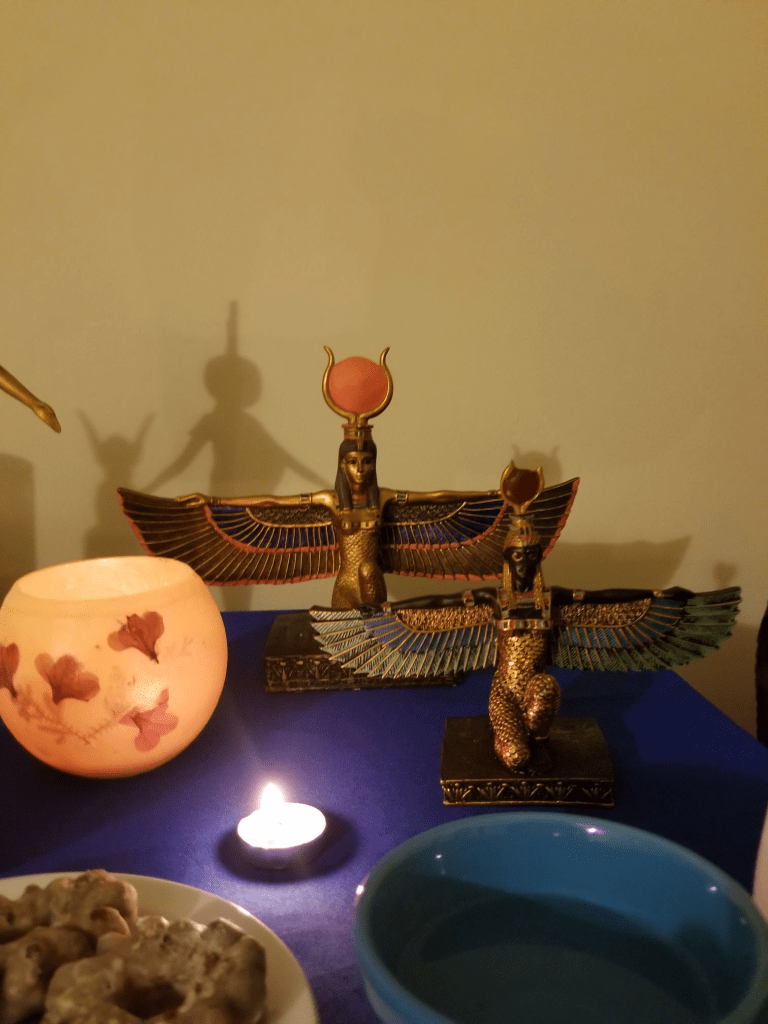
Day: 4th Shomu, Day 2.
On my calendar this festival falls on July 2.
This festival commemorates Aset’s nightly search by torchlight for Her husband Wesir. Candles, lamps and torches were lit for the Goddess. Papyrus boats were launched in temple lakes. The boats had prayers written on them with a light source to guide the way.
Ritual for Today
This ritual is what we do for this festival in the House of Netjer.
On Aset’s shrine you could have: an image or statue of the Goddess, a source of light from candles, lamps, LED candles or electric candles and offerings.
You will need paper and a pen or pencil or marker (not red). You will also need a tealight and a lighter.
Write a letter, telling Aset things you are thankful for. Then on the other side, write a letter to Aset asking for things you need. This paper later gets folded into the boat (start folding: thank you side up).
After the paper boats are made, fill a bowl, bathtub or sink with water. A tealight is placed in each boat and they are put in the water. The tealights are lit and the boats float on the water until the candles burn out. (Please keep fire safety in mind).
Thank You/Gratitude Letter Ideas
- Family
- Friends
- Pets
- House/Apartment/Condo
- Food
- Health
- Job
- Vaccines
- Other Things She has helped you with
Ideas of Things You Need
- Vaccine for Covid 19
- Good Health
- Prosperity
- Love
- Self-Love
- Healing
- Healing from Grief
- Fortitude and Strength
- Job
Remember to eat the offerings when you are done. And extinguish the candles.
About Aset
Aset is a goddess of sovereignty, kingship, magic of all kinds, life-power, personal power and authority, writing, words, gaining knowledge, honoring one’s ancestors, ancestral lineage and traditions, dreams, family relationships, self-love, alignment of the souls and healing. She is also a goddess of Heaven, starlight, the night sky and the star Sopdet (Sirius).
I channeled this message from Aset about this festival.
(This is included in my book, Queen of the Road)
Aset Luminous (Aset, the Fiercely Bright One)
by JewelofAset
What are you doing for Her festival?
What will you do today for the Fiercely Bright One?
Light candles or lamps? Sing a hymn? Perform ritual before Her shrine? What will you offer to the Lady?
What will you do today for the Mother of God? The one who gave birth to Heru in the Marshes? The sole Mother who took care of Her son?
What will you do for Aset, the Fiercely Bright One? The One who leads the way in the darkness, dispelling shadows with Her light? The stellar and solar goddess of the dawn.
What will you do today? What will you accomplish? What will you profess?
What will you ask Me in your letter? What prayers and hopes will the boats carry on the water, with My light guiding the way?
What will you ask Me to dispel in your lives? What will you ask Me to cultivate?
What will you do for the Fiercely Bright One? What will you ask of the Brightest of Stars? What will you ask of the Solar Goddess?
I am the Mistress of Magic. I am the Goddess Who Knows Her Spells. What I speak comes to pass.
Do not worry, child. I will take care of you.
Who am I? Am I not the Goddess who knows Ra’s Name? Am I not the wisest and cleverest of Gods? Am I not the Goddess of all magic, all heka, all life-power, all kau?
So what will you ask Me on My festival day?
The words you speak and write have power. What I speak comes to pass. What you write is your heart’s desire.
For what you do, what you say and what you write will become.

